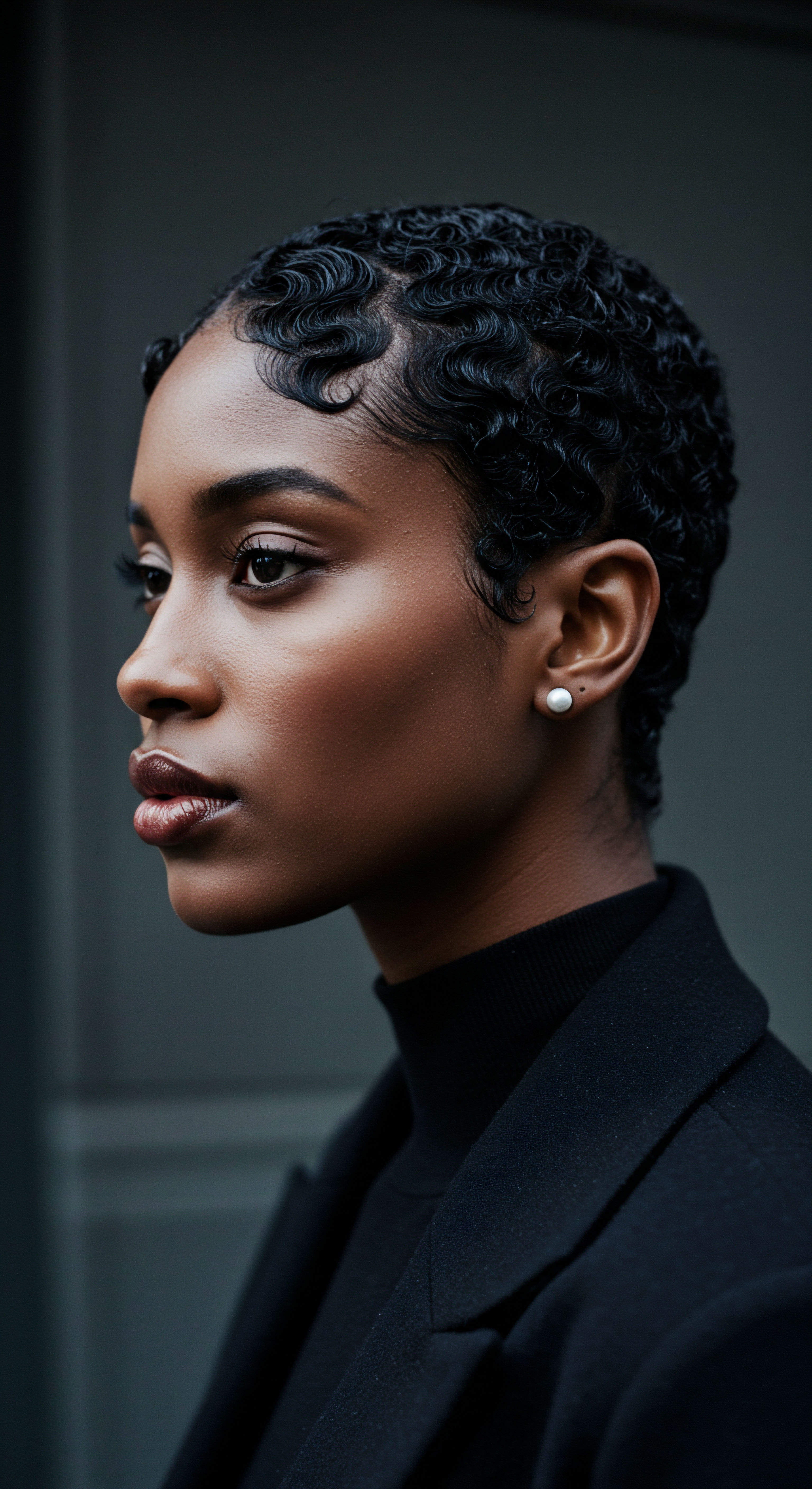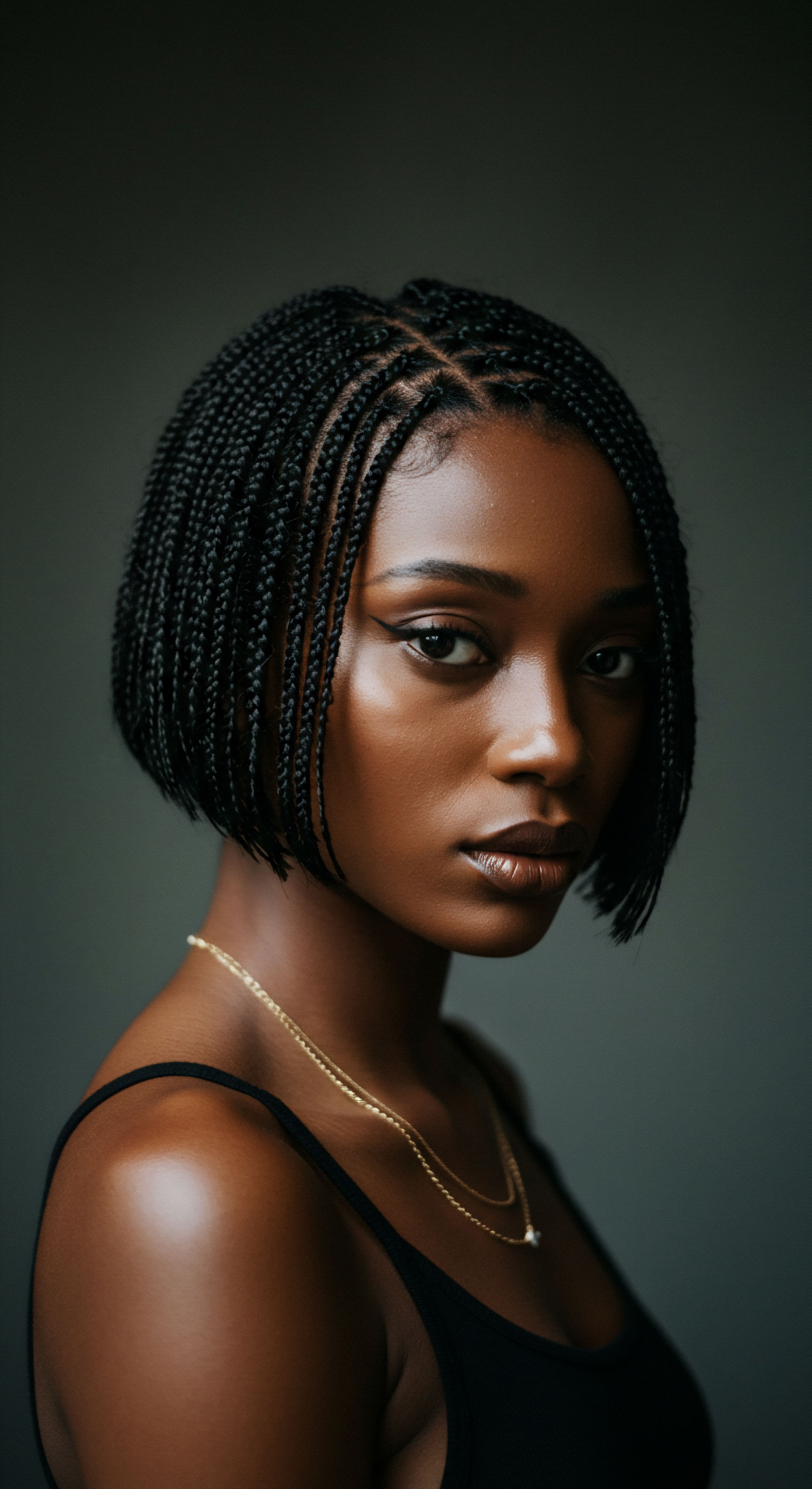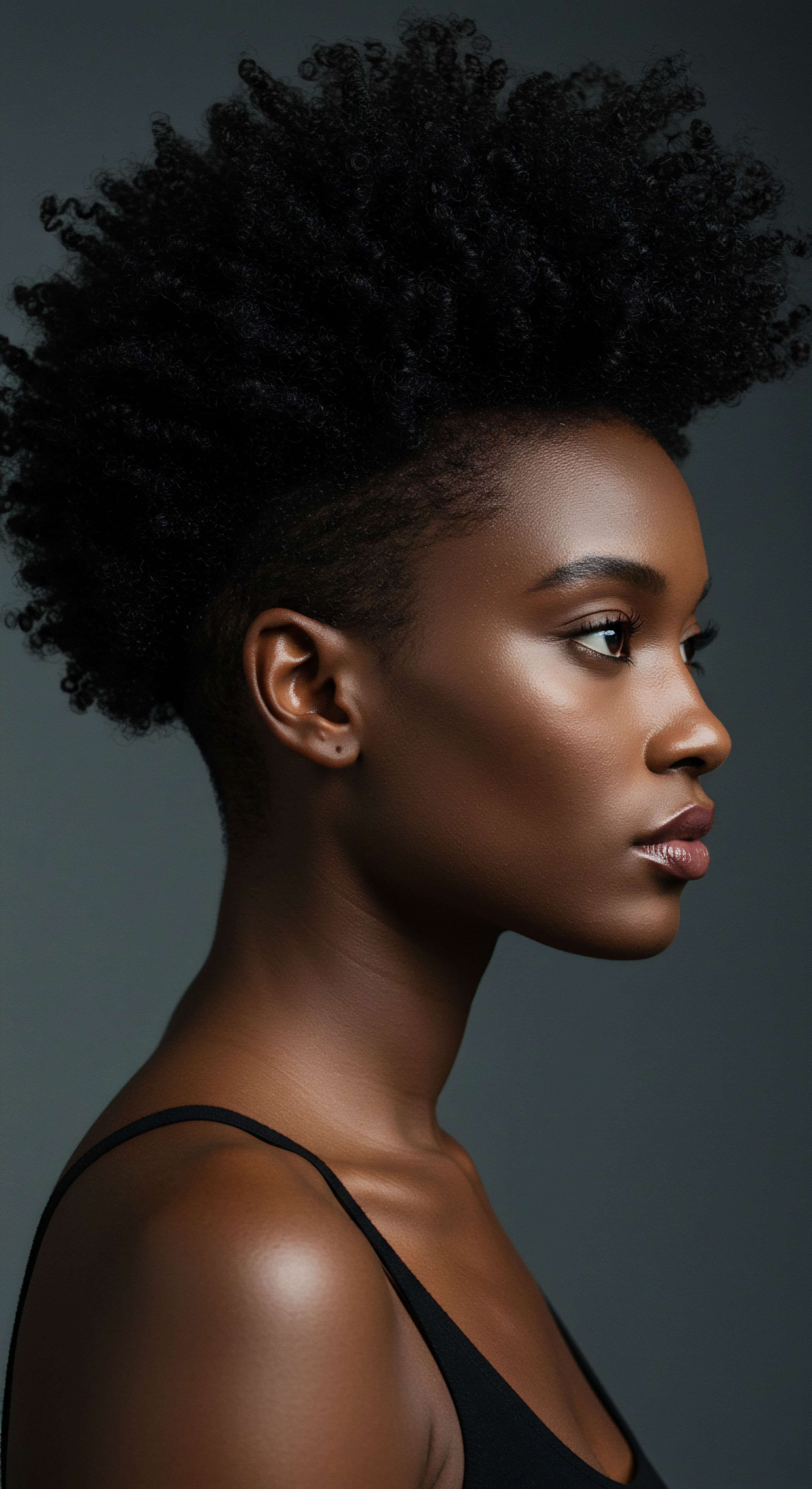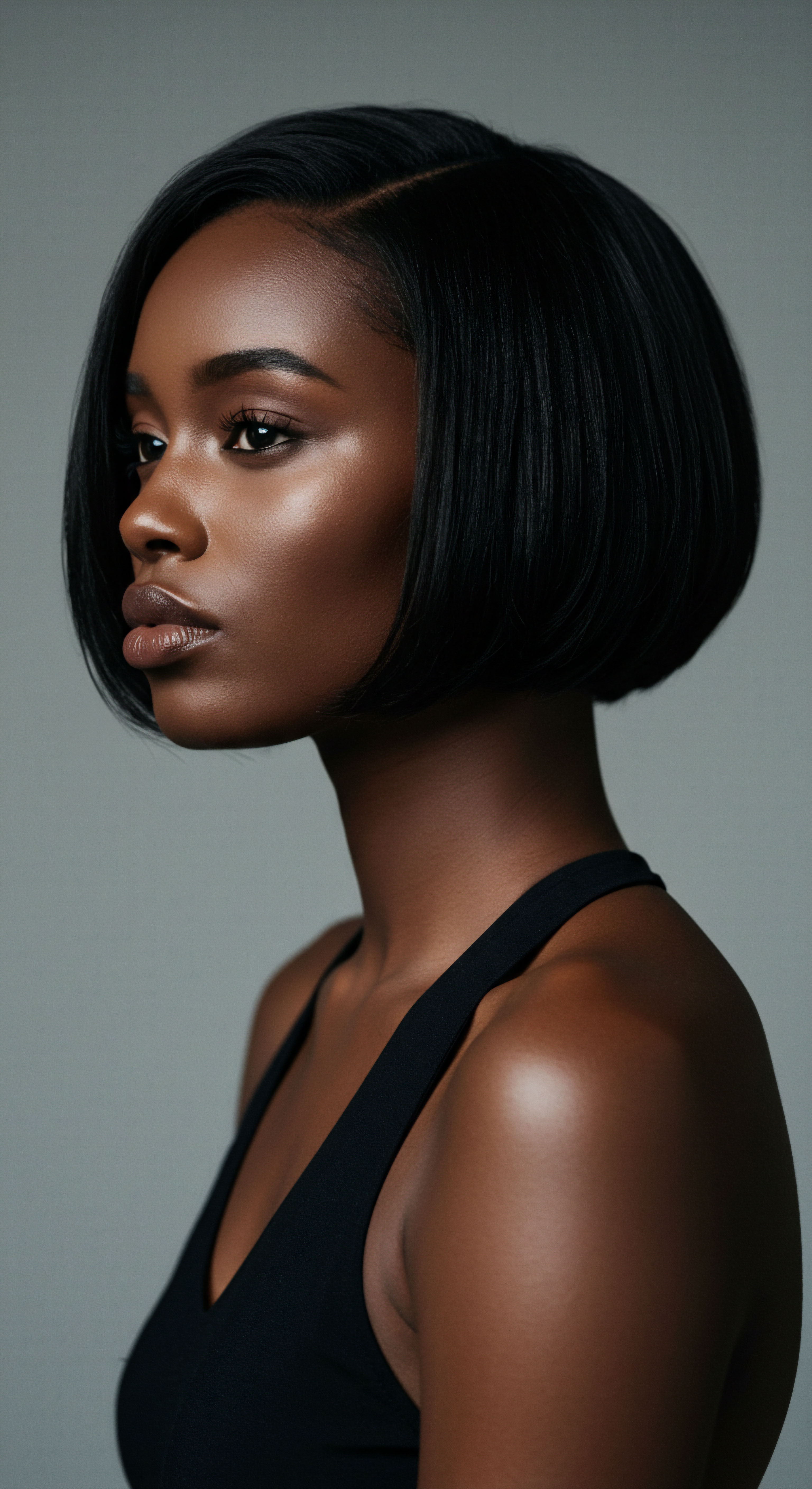
Roots
The hush of evening often ushers in a quiet contemplation, a moment when the day’s exertions begin to recede, and the subtle needs of our physical selves draw into sharper focus. For those graced with textured hair, this twilight transition carries a particular weight, a gentle whisper about the protection and care that slumber demands. We speak not merely of covering the head, but of a deep, resonant practice, one that acknowledges the very essence of curls, coils, and waves as they meet the friction of the night.
This understanding, rooted in the foundational characteristics of textured strands, illuminates why the choice of sleep material holds such profound significance. It is a dialogue between hair and its environment, a conversation that has echoed through generations and across continents, long before modern science articulated its every detail.

Hair’s Delicate Architecture
At its core, textured hair possesses a unique architectural blueprint, distinct from its straighter counterparts. Each strand, when viewed under powerful magnification, reveals a complex dance of cuticle scales, those tiny, overlapping layers that form the outermost protective sheath. In straight hair, these scales lie relatively flat, presenting a smooth surface. With textured hair, particularly tighter coils, these cuticles tend to be naturally lifted, or even slightly irregular, creating microscopic points of potential vulnerability.
This inherent structure, while lending itself to incredible volume and diverse styling possibilities, also means that textured hair can be more susceptible to moisture loss and mechanical stress. The very curves and bends that give textured hair its distinctive beauty also create more surface area for friction to occur, and more opportunities for moisture to escape.
Consider the hair shaft’s cross-sectional shape, often elliptical or flattened in textured hair, which contributes to its coiling pattern. This shape, combined with the uneven distribution of disulfide bonds along the hair shaft, dictates the curl’s tightness and resilience. When these delicate structures encounter abrasive surfaces, such as common bedding fabrics, the consequences can be significant.
The raised cuticles can snag, lift further, or even chip away, leading to frizz, dullness, and ultimately, breakage. This microscopic assault, repeated night after night, chips away at the hair’s vitality, compromising its strength and sheen.
The very architecture of textured hair, with its naturally lifted cuticles and unique cross-sectional shape, renders it particularly susceptible to the abrasive forces encountered during sleep.

The Language of Hair’s Well-Being
To truly appreciate the needs of textured hair at night, one must understand its intrinsic thirst. Textured hair often struggles with maintaining hydration due to its structural characteristics. The natural oils produced by the scalp, known as sebum, travel down the hair shaft with greater difficulty on a coiled path compared to a straight one.
This means the ends of textured hair often receive less natural conditioning, making them prone to dryness. This dryness, coupled with the potential for cuticle damage, creates a cycle where hair becomes more brittle, more prone to tangles, and less resilient.
Understanding this natural predisposition to dryness shapes our approach to nighttime care. The goal extends beyond merely preventing tangles; it seeks to create an environment where the hair’s precious moisture is preserved, where friction is minimized, and where the strands can rest undisturbed, allowing their inherent beauty to persist. The materials chosen for nighttime protection become silent guardians in this nightly ritual, acting as a barrier against the very forces that would otherwise diminish hair’s vibrancy.

Why Sleep Protection Matters for Textured Hair
The necessity of sleep protection for textured hair stems directly from its anatomical and physiological realities. As we shift and turn during sleep, our hair rubs against the surface of our pillowcases or bedding. Standard cotton, with its short, coarse fibers, acts like a microscopic sponge, absorbing moisture from the hair and creating significant friction. This abrasive interaction can lead to ❉
- Moisture Depletion ❉ Cotton’s absorbent nature strips hair of its vital hydration, leaving it dry and brittle.
- Cuticle Disruption ❉ The friction causes the hair’s delicate cuticle layers to lift, leading to frizz, dullness, and tangles.
- Mechanical Stress ❉ Constant rubbing weakens the hair shaft, making it prone to splitting and breakage over time.
By contrast, materials designed for hair protection create a smooth, low-friction surface that allows hair to glide rather than snag. They also possess properties that do not absorb hair’s natural moisture, thus preserving its hydration levels. This distinction marks the fundamental divergence between materials that harm and those that preserve the health and vitality of textured hair during its most vulnerable hours.

Ritual
As the sun dips below the horizon and the world prepares for rest, a gentle shift in focus occurs, turning towards the mindful practices that safeguard our textured strands through the night. This is where the wisdom of understanding hair’s structure meets the practical application of care, transforming a simple act into a deliberate ritual. It is about selecting the right allies for this nightly repose, not merely as objects, but as integral components of a holistic approach to hair wellness. The choice of material becomes a silent promise to the hair, a commitment to its preservation against the unseen forces of friction and dehydration that the hours of sleep can bring.

The Silken Sanctuary and Its Alternatives
When considering the optimal materials for nighttime hair protection, two contenders rise above the rest ❉ silk and satin. While often conflated, their distinctions are noteworthy, yet both offer a significant improvement over traditional cotton.

Why Silk Holds a Special Place?
Silk, a natural protein fiber produced by silkworms, stands as a premier choice. Its smooth, tightly woven fibers present a remarkably low-friction surface, allowing hair to glide freely without snagging or causing mechanical stress. Beyond its gentle touch, silk is a poor absorber of moisture. This characteristic means it will not draw hydration from your hair, preserving its natural oils and applied products.
The protein structure of silk is also thought to be somewhat similar to hair’s own keratin, making it particularly compatible. The measurement of silk quality, known as momme weight, indicates its density and durability; a higher momme weight generally signifies a more luxurious and lasting fabric.

Understanding Satin’s Appeal
Satin, by contrast, refers to a weave pattern, not a fiber type. While it can be made from silk, it is most commonly crafted from synthetic fibers like polyester or nylon. The satin weave creates a lustrous, smooth surface similar to silk, providing significant friction reduction. For many, satin offers an accessible and cruelty-free alternative to silk, delivering many of the same protective benefits at a more approachable price point.
While synthetic satin may not possess silk’s natural breathability or protein compatibility, its smoothness remains its primary virtue for hair care. The key is to seek out high-quality synthetic satins that maintain their smooth finish and do not pill or roughen with use.
Both silk and satin, whether in the form of bonnets, scarves, or pillowcases, serve the same fundamental purpose ❉ to create a protective barrier that minimizes friction and helps retain moisture. The choice between them often comes down to personal preference, budget, and ethical considerations.
Silk and satin stand as prime choices for nighttime hair protection, both minimizing friction and aiding moisture retention, with silk offering natural benefits and satin providing an accessible alternative.

Implementing Nightly Hair Protection
The effectiveness of sleep materials extends beyond mere acquisition; it lies in their consistent and thoughtful application. Integrating these materials into a nightly regimen can take various forms, each suited to different hair lengths, textures, and personal preferences.
- The Bonnet’s Embrace ❉ A satin or silk bonnet offers a comprehensive enclosure for the hair, protecting all strands from friction and environmental elements. Look for bonnets with a comfortable, secure elastic band that does not cause tension around the hairline. They are particularly beneficial for preserving defined styles, such as twist-outs or braid-outs, by keeping them undisturbed.
- The Scarf’s Versatility ❉ A silk or satin scarf provides a customizable method of protection. It can be tied in various ways to accommodate different styles, from wrapping straightened hair to securing a pineapple for curl preservation. The scarf offers greater flexibility in how much tension is applied and allows for creative styling while protecting.
- The Pillowcase’s Foundation ❉ A satin or silk pillowcase serves as a foundational layer of defense, even if a bonnet or scarf is also used. It ensures that should hair escape its primary covering, or for those who prefer not to cover their hair directly, the hair still rests on a gentle surface. This is a simple yet impactful change for anyone seeking to improve their hair’s nighttime experience.

Beyond the Fabric The Art of Preparation
While the material choice is paramount, the manner in which hair is prepared before encountering these protective surfaces also plays a significant role. This pre-sleep preparation is a silent dialogue with the hair, setting the stage for its restful night.

Preserving Defined Styles
For those who wear their hair in defined curl patterns or straightened styles, specific techniques prior to covering can extend the life of the look. The “pineapple” method, where hair is gathered loosely at the very top of the head and secured with a soft scrunchie, lifts the hair off the neck and pillow, reducing compression and friction on the length of the strands. For stretched or straightened hair, wrapping techniques or large, loose braids can help maintain smoothness and prevent kinks.

Moisture Sealing
Before encasing hair in its protective layer, a light application of a moisturizing cream or a sealing oil can further bolster its hydration. This acts as a nightly treatment, locking in moisture and providing an additional layer of protection against dryness. The non-absorbent nature of silk and satin then ensures that these products remain on the hair, rather than being wicked away. This combination of material and thoughtful preparation creates an optimal environment for hair to thrive, ensuring that each morning greets you with strands that feel refreshed, soft, and ready for the day.

Relay
Stepping beyond the immediate touch and feel of sleep materials, we find ourselves on a deeper exploration, one that connects the tactile experience to the profound impact on hair’s long-term vitality and even its cultural significance. The selection of nighttime hair coverings is not merely a superficial choice; it is a testament to an enduring wisdom, a scientific understanding of hair’s delicate needs, and a subtle acknowledgment of identity. This section delves into the underlying mechanisms, the less apparent considerations, and the broader context that elevates a simple material choice into a powerful act of care and self-preservation.

The Microscopic Dance of Friction and Hydration
At the heart of the matter lies the delicate interplay between hair and its environment at a microscopic scale. The cuticle, the outermost layer of the hair shaft, functions like a protective armor. When hair rubs against a rough surface, these cuticles are forced open, leading to a cascade of undesirable effects. This physical abrasion not only causes the scales to lift and fray, resulting in frizz and a dull appearance, but also creates channels through which precious moisture can escape.
A study published in the Journal of Cosmetic Science (Robins, et al. 1999) explored the effects of various textile surfaces on hair fiber damage. While not directly comparing silk to cotton pillowcases, the research highlighted how different surface roughness values of textiles correlate with the amount of cuticle damage observed on hair fibers after repeated friction. The findings indicated that smoother surfaces caused significantly less disruption to the cuticle layer.
This underscores the core principle ❉ the smoother the material, the less damage inflicted upon the hair’s protective outer sheath. What often goes unsaid is the sheer cumulative effect of this nightly friction; even seemingly minor damage, repeated over hundreds of nights, can lead to significant structural compromise and breakage over time.
The role of material in moisture retention is equally compelling. Cotton, being a hydrophilic (water-loving) fiber, readily absorbs moisture. When hair, particularly textured hair that is often drier by nature, rests on a cotton pillowcase, the cotton acts as a wick, drawing hydration away from the hair strands. Silk, conversely, is hydrophobic (water-repelling) to a degree, and its tightly woven structure does not absorb moisture in the same manner.
This means that any conditioners, oils, or natural sebum present on the hair remain on the hair, contributing to its hydration and suppleness. This preservation of moisture is paramount for textured hair, as adequate hydration is the cornerstone of elasticity, strength, and overall hair health.

Beyond the Material How Does Culture Shape Nighttime Care?
The practice of covering hair at night, particularly within Black and mixed-race communities, carries a rich historical and cultural lineage that extends far beyond mere functional protection. It speaks to a heritage of hair care that was often a necessity, a means of preserving styles created with considerable effort, and a quiet act of self-preservation. In many cultures, hair holds spiritual, social, and personal significance. Protecting it, even during sleep, becomes an extension of respecting one’s heritage and identity.
Historically, head coverings in African and diasporic cultures served diverse purposes ❉ status, spiritual observance, and practical protection from the elements. The transition of these practices into nighttime rituals for hair care speaks to a deep, intergenerational understanding of textured hair’s needs. The bonnet or scarf, therefore, is not simply a piece of fabric; it is a symbol of continuity, a nod to ancestral wisdom, and a daily affirmation of self-care.
This cultural dimension adds a layer of depth to the material choice, imbuing it with meaning beyond its scientific benefits. It connects the individual’s nightly routine to a broader collective experience, reinforcing the idea that caring for textured hair is a practice steeped in both practical knowledge and cultural reverence.
Nightly hair protection, particularly within Black and mixed-race communities, transcends mere functionality, serving as a continuation of ancestral wisdom and a profound act of cultural affirmation.

The Economic and Environmental Considerations
The choice of sleep material also invites consideration of its broader impact. While silk may represent a higher initial investment, its durability and the long-term benefits to hair health can offset this cost. Reduced breakage means less need for restorative treatments, fewer expensive products to compensate for damage, and potentially longer periods between trims to remove split ends. This subtle economic advantage, often overlooked, contributes to a more sustainable hair care routine.
From an environmental perspective, the sourcing and production of materials like silk and synthetic satin also present a complex picture. Silk production can be resource-intensive, while synthetic satins, derived from petroleum, carry their own environmental footprint. However, the longevity of a quality silk or satin product, when cared for properly, means less frequent replacement, reducing waste. This consideration invites a more holistic view of our consumption, weighing immediate cost against the broader implications for both personal well-being and planetary health.
| Material Silk |
| Friction Reduction Excellent |
| Moisture Retention Excellent |
| Durability High (with proper care) |
| Cost Accessibility Higher |
| Material Satin (Synthetic) |
| Friction Reduction Very Good |
| Moisture Retention Very Good |
| Durability Moderate to High |
| Cost Accessibility Moderate |
| Material Cotton |
| Friction Reduction Poor |
| Moisture Retention Poor |
| Durability High |
| Cost Accessibility Low |
| Material Choosing the right material balances initial investment with long-term hair health and environmental considerations. |

Can the Right Material Choice Prevent Hair Loss?
While the direct prevention of hair loss is a complex issue influenced by genetics, hormones, and overall health, the consistent use of appropriate nighttime materials can certainly play a supportive role in minimizing mechanical hair loss. Hair loss can manifest in various ways, including breakage along the hair shaft. When hair is constantly subjected to friction and abrasion during sleep, it weakens the hair shaft, making it more prone to snapping. This type of loss, often seen as short, broken strands, can be significantly reduced by creating a low-friction sleep environment.
A well-preserved cuticle layer, maintained by gentle sleep surfaces, ensures the hair retains its strength and elasticity. This resilience means strands are less likely to break from daily manipulation or styling, thereby preserving the hair’s overall density and length. It is not a cure for underlying conditions causing hair loss, but a vital preventative measure against externally induced damage that can mimic or exacerbate thinning. This preventive aspect of material choice highlights its often-underestimated significance in a comprehensive hair care strategy.

Reflection
The quiet hours of night, often perceived as a period of simple rest, hold a deeper significance for the vitality of textured hair. Our exploration has traversed the delicate architecture of each strand, journeyed through the mindful rituals of protection, and considered the profound implications of material choice, both scientific and cultural. It becomes clear that the seemingly small act of selecting a silk pillowcase or a satin bonnet is far from trivial. It is a deliberate gesture, a quiet affirmation of care that acknowledges the hair’s inherent needs and respects its unique heritage.
This nightly practice, steeped in both ancestral wisdom and modern understanding, transforms the vulnerable hours of sleep into a sanctuary for our strands, allowing them to retain their strength, their moisture, and their radiant spirit. The journey with textured hair is an ongoing dialogue, and the materials we choose for its nocturnal embrace speak volumes about our commitment to its lasting well-being.

References
- Robins, A. H. Van den Bergh, R. & Bhana, R. (1999). An in vitro study of the effects of textile surfaces on hair fiber damage. Journal of Cosmetic Science, 50(2), 99-112.
- Dawber, R. P. R. (2002). Diseases of the Hair and Scalp. Blackwell Science.
- Khumalo, N. P. & Ngwanya, R. M. (2012). The art of hair care in women of African descent. Clinical Dermatology, 30(2), 173-181.
- Barel, A. O. Paye, M. & Maibach, H. I. (Eds.). (2014). Handbook of Cosmetic Science and Technology. CRC Press.
- Tosti, A. & Piraccini, B. M. (2015). Hair and Scalp Diseases ❉ Medical, Surgical, and Aesthetic Treatments. CRC Press.
- Marsh, J. M. (2017). Hair ❉ A Cultural History. University of Minnesota Press.
- Burgess, C. (2017). Cosmetic Dermatology. CRC Press.